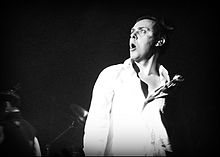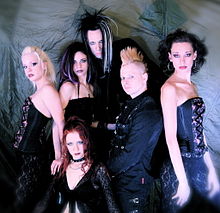- Dark Wave
-
For the 1956 documentary film, see The Dark Wave.
Dark Wave Stylistic origins New Wave, post-punk, gothic rock, industrial, synthpop Cultural origins late 1970s to early 1980s Europe (most notably England, Germany, France and Italy). Typical instruments Guitar, bass, synthesizer, drums, drum machine, piano, violin Mainstream popularity Low to moderate in 1980s United States and Europe, mostly underground since then Subgenres Coldwave, Ethereal Wave, Neoclassical
(complete list)Fusion genres Gothic rock Regional scenes Coldwave Other topics Notable releases Dark Wave or darkwave is a music genre that began in the late 1970s, coinciding with the popularity of New Wave and post-punk. Building on those basic principles,[1] dark wave added dark, introspective lyrics and an undertone of sorrow for some bands. In the 1980s, a subculture developed alongside dark wave music, whose members were called "wavers"[2][3] or "dark wavers".[4][5]
Contents
History
 Peter Murphy with Bauhaus in 2006
Peter Murphy with Bauhaus in 2006
1980s
The term was coined in Europe in the 1980s to describe a dark and melancholy variant of New Wave and post-punk music, such as gothic rock and dark synthpop, and was first applied to musicians such as Bauhaus,[6] Joy Division,[7][8][9] The Cure,[8][10] Siouxsie and the Banshees,[8] and The Chameleons.[8]
The movement spread internationally, spawning such developments as French coldwave. Coldwave described groups such as KaS Product,[11] Martin Dupont, Asylum Party, Norma Loy, Pavillon 7B, Résistance, Clair Obscur, Opera Multi Steel, The Breath of Life, and Trisomie 21. Subsequently, different dark wave genres merged and influenced each other, e.g. electronic New Wave music (also called Electro Wave in Germany) with gothic rock, or used elements of ambient and post-industrial music. Attrition,[12] In The Nursery and Pink Industry (UK), Clan of Xymox (Netherlands), Mittageisen (Switzerland),[13] Die Form (France), and Psyche (Canada) played this music in the 1980s. German dark wave groups of the 1980s were associated with the Neue Deutsche Welle, and included Asmodi Bizarr, II. Invasion, Unlimited Systems, Mask For, Moloko †, Maerchenbraut,[14] and Xmal Deutschland.
1990s
After the New Wave and post-punk movements faded in the mid-1980s, dark wave was renewed as an underground movement by German bands such as Deine Lakaien,[14][15] Love Is Colder Than Death, early Love Like Blood,[16] and Diary of Dreams,[17] as well as Project Pitchfork,[14] and Wolfsheim.[18] The Italians The Frozen Autumn, Ataraxia, and Nadezhda,[19] the South African band The Awakening and the French Corpus Delicti, also practiced the style. All of these bands followed a path based on the New Wave and post-punk movements of the 1980s. At the same time, a number of German artists, including Das Ich,[14][17] Relatives Menschsein and Lacrimosa, developed a more theatrical style, interspersed with German poetic and metaphorical lyrics, called Neue Deutsche Todeskunst (New German Death Art). Other bands, such as Silke Bischoff, In My Rosary and Engelsstaub mingled dark synthpop or goth rock with elements of the Neofolk or Neoclassical genres.[17]
After 1993, in the United States, the term dark wave (as the one-word variant darkwave) became associated with the Projekt Records label, because it was the name of their printed catalog, and was used to market German artists like Project Pitchfork in the U.S. Projekt features bands such as Lycia, Black Tape for a Blue Girl, and Love Spirals Downwards, most of these characterized by ethereal female vocals.[20] This style took cues from 1980s bands, like Cocteau Twins. This music is often referred to as Ethereal Darkwave.[21] The label has also had a long association with Attrition, who appeared on the label's earliest compilations. Another American label in this vein was Tess Records, which featured This Ascension and Faith and the Muse.[22] Clan of Xymox, who had returned to their 1980s sound, following almost a decade as the more synthpop Xymox, also signed to Tess in 1997.
Joshua Gunn, a professor of communication studies at Louisiana University, described American darkwave as
“ an expansion of the rather limited gothic repertoire into electronica and, in a way, the US answer to the 'ethereal' subgenre that developed in Europe (e.g. Dead Can Dance). Anchored by Sam Rosenthal's now New York-based label, Projekt, Darkwave music is less rock and more roll, supporting bands who tend to emphasize folk songcraft, hushed vocals, ambient experimentation, and synthesized sounds more akin to the brief 'shoegaze' movement in alternative rock than the punk styles of early gothic music. [...] Projekt bands like Love Spirals Downward and Lycia are the most popular of this subgenre.[22] ” 2000s
Black metal band Cradle of Filth was referred to by The IT Crowd character Richmond Avenal as being a "contemporary darkwave band" in the Season 1 episode "The Red Door".
Wave-atypical influences
A number of other U.S. bands mixed elements of dark wave and ethereal wave with later developments in electronic music.[citation needed] Love Spirals Downwards, Collide, and Switchblade Symphony incorporated elements of trip hop,[citation needed] while The Crüxshadows combined a range of contemporary electronic dance music elements with their synth-based alternative rock style.[citation needed]
Bibliography
Mercer, Mick. Hex Files: The Goth Bible. New York: The Overlook Press, 1997.
References
- ^ Arvid Dittmann · Artificial Tribes · Jugendliche Stammeskulturen in Deutschland · Page 139 · 2001 · ISBN 3-933773-11-3
- ^ Klaus Farin · Die Gothics · Interview with Eric Burton from the German music group Catastrophe Ballet · Page 60 · 2001 · ISBN 3-933773-09-1
- ^ Peter Matzke / Tobias Seeliger · Gothic! · Interview with Bruno Kramm from the German music group Das Ich · Page 217 · 2000 · ISBN 3-89602-332-2
- ^ Glasnost Wave-Magazin · Heft-Nr. 21 · Interview with the music group Girls Under Glass · Page 8 · May 1990
- ^ Glasnost Wave-Magazin · Heft-Nr. 31 · Review for an album of the music group Calling Dead Red Roses · Page 34 · January/February 1992
- ^ Peter Matzke / Tobias Seeliger · Das Gothic- und Dark-Wave-Lexikon · Page 39 · 2002 · ISBN 3-89602-277-6
- ^ New Life Soundmagazine · Issue No. 38 · Description of the single "Love Will Tear Us Apart“ · Page 10 · November 1988
- ^ a b c d Kirsten Wallraff · Die Gothics · Musik und Tanz · Page 47 · 2001 · ISBN 3-933773-09-1
- ^ Peter Jandreus, The Encyclopedia of Swedish Punk 1977-1987, Stockholm: Premium Publishing, 2008, p. 11.
- ^ Ingo Weidenkaff · Jugendkulturen in Thüringen · Die Gothics · Page 41 · 1999 · ISBN 3-933773-25-3
- ^ Mick Mercer, Gothic Rock, Los Angeles: Cleopatra Records, p. 112.
- ^ "Composing noises". Sorted magAZine. 1999. http://sortedmagazine.com/archive/magazine/sordid/attrition.htm.
- ^ Donnacha DeLong (1999). "Sordid Reviews February 1999". Sorted magAZine. http://www.sortedmagazine.com/archive/magazine/sordid/feb99.htm#mittag.
- ^ a b c d Kilpatrick, Nancy. The Goth Bible: A Compendium for the Darkly Inclined. New York: St. Martin's Griffin, 2004, ISBN 0-312-3069602, p. 85.
- ^ [1]
- ^ Glasnost Wave-Magazin · Issue No. 23 · Interview with the German music group Love Like Blood · Page 13 · September 1990
- ^ a b c Mercer, p. 34-46.
- ^ [2]
- ^ Mercer, p. 55-61
- ^ Mercer, p. 136-144.
- ^ Glasnost Wave-Magazin · Issue No. 42 · Description of the bands Trance to the Sun, This Ascension and others · Pages 32/34 · Germany · April 1994
- ^ a b Kilpatrick, Nancy. The Goth Bible: A Compendium for the Darkly Inclined. New York: St. Martin's Griffin, 2004, ISBN 0-312-3069602, p. 90.
External links
- "England Fades Away: Stylus Magazine's Guide to Goth." StylusMagazine.com article on gothic rock.
- Cold Wave Years
See also
Goth subculture Music Gothic rock - Dark Wave - Post-punk - Deathrock - Horror punk - Ethereal Wave - Neoclassical - Dark cabaret - Gothabilly - Neofolk - Gothic metal - Symphonic metalRegional scenes Notable events Other New Wave music Regional scenes Other topics Categories:- Darkwave
- New Wave music
- Music scenes
- Fusion music genres
Wikimedia Foundation. 2010.


